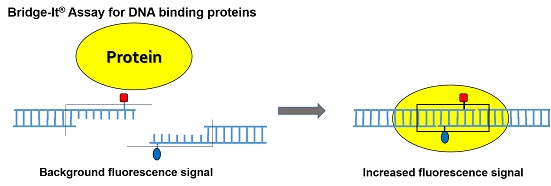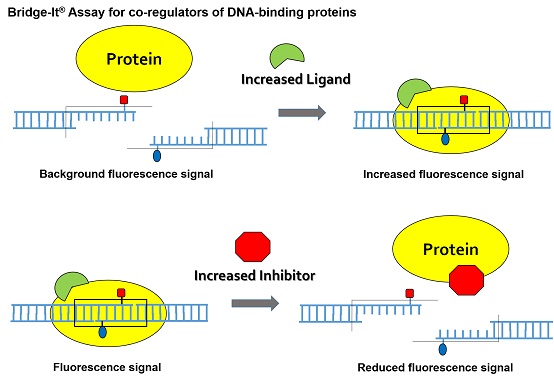Bridge-It® Assay Platform Technology
Measure DNA-Binding Proteins and Their Ligands
Eukaryotic cells contain an estimated 3,000 sequence-specific DNA-binding proteins. These important proteins, acting either with or without a protein-specific small molecule co-regulator (ligand), control all aspects of genomic DNA activity including gene expression, DNA replication, and DNA repair. Mediomics is applying its proprietary fluorescence platform to develop in vitro assays capable of rapidly and sensitively quantifying both DNA-binding proteins and their ligands.
Fluorescence Assay Platform Design
The common property of all sequence-specific DNA-binding proteins is their ability to bind with high affinity and specificity to a DNA duplex containing a unique nucleotide sequence, i.e., the DNA-binding site for the protein. Mediomics’ novel assay platform relies on this common characteristic. A DNA duplex containing the sequence-specific DNA-binding site for a given target protein is split into two DNA half-site duplexes each having a short single-stranded overhang. These single-stranded extensions are short enough so that in the absence of the target protein little spontaneous re-association occurs. When the target protein is present, however, its high affinity for the full-length DNA sequence binding site will drive the re-association of the two half-site DNA duplexes. This re-association can be sensitively detected by incorporating an appropriate fluorescence probe into each one of the two DNA half-sites. The presence of the DNA-binding protein is detected as a change in fluorescence signal (Figure 1).

A simple variation of this basic platform design allows a DNA-binding protein to function as a sensitive biosensor for its specific co-regulator or ligand (Figure 2). The ligand (target molecule) binds to the specific binding site on its specific ligand-dependent DNA binding protein. This small target molecule recognition event serves to activate the DNA-binding site on the DNA-binding protein. The fluorescence signal generated will now be reporting the presence of the co-regulator (ligand). The Bridge-It® cAMP assay is an example of such an assay design.

Bridge-It® Assay Platform Technology Background

Applications of the Bridge-It® Assay Platform
Features of the Bridge-It® Assay Platform
The Bridge-It® Assay is a simple, rapid, safe, and affordable method for measuring the activity of DNA binding proteins and their co-regulators.
- It is sensitive, rapid and homogeneous procedure that requires no technical manipulations other than mixing the test sample with the reaction mixture.
- It does not require the use of antibodies or radioactive probes.
- It can be used for real-time measurement of sequence-specific DNA-binding factors from any organism using any of the currently available test platforms (e.g., microplates, fiber-optic arrays, biochip arrays, etc.)
- It is flexible with respect to the mode of signal detection and the fluorescence probe used.
- It is amenable to performance of simultaneous multi-color detection of several different DNA-binding proteins.
- It can be formatted for research use as kits products and in arrays for purposes of high-throughput screening.
Comparison of the Bridge-It® Assay Platform with ELISA
The Bridge-It® Assay requires much less time, effort, and reagent than enzyme-linked immunosorbent assay. See how the work flow for each assay compares in the table below.

